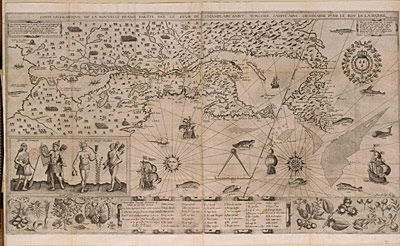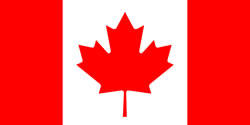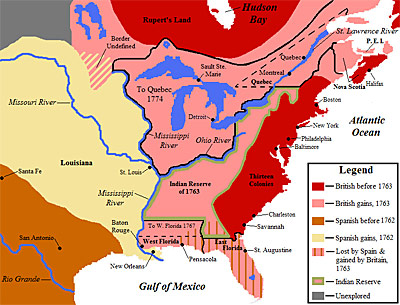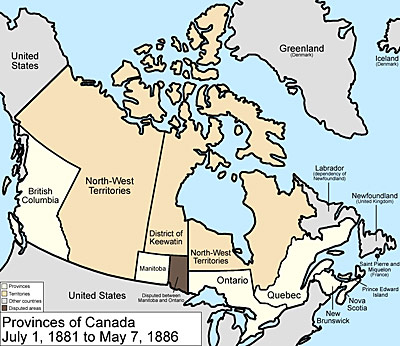
Unit 3: Revolutions and Reaction
Lesson D: The Americas — Land of Revolutionary Opportunity
Activity 7: Democracy and Independence in Canada
Like Latin American countries, Canada became self-governing during the 19th century but unlike Latin American countries and the United States, official independence was not achieved until well into the 20th century. Still, Enlightenment thought and nationalism did play a role in the evolution of Canadian self rule and independence.
Read the quote below from a Canadian Professor of Political Science:
Canada's transition from a self-governing British colony into a fully independent state was an evolutionary process, which arose in such a gradual fashion that it is impossible to ascribe independence to a particular date. [1]
Canada’s modern history is linked to European colonization of North America. Following the age of exploration and initial contact of the 1500s, Europeans became increasingly interested in Canada’s resources, such as animal furs and timber. Most of the eastern half of Canada was part of the French colonial territory of "New France."

Map of New France by Samuel de Champlain, 1612-1613 [2]
Canada became a British colony in North America as a result of the French and Indian War (1754-1763). Like Canada today, there was both an English speaking and a French speaking population. The French speaking people were concentrated mostly in Quebec. Canada became more dominantly English speaking during the American Revolution. 30,000 British Loyalist moved to Canada from the colonies, strengthening the loyalty of the colony to Britain.
There were tensions between the French and English populations. In 1791, the colony was divided into Upper Canada (English) and Lower Canada (French). Each had its own governor and legislature, but both were still ruled by Britain. By 1837, people in both Upper and Lower Canada became frustrated with the amount of control the British had in local government. These frustrations turned to rebellion in both parts of the colony. The rebellions were small with few casualties, but they did signal the British government that changes would have to be made if they didn't want another revolution like the American Revolution to the south.
The British government sent the Earl of Durham to Canada to recommend and carry out reforms. Under the Canada Act of 1840, Upper and Lower Canada were reunited. It was Durham's hope that this unification would overwhelm the French influence in the colony and Canada would develop a fully English culture. He also put control of all domestic affairs in the hands of a Canadian legislature. The British would continue to control foreign policy and be responsible for defense, but in other areas, Canada became self governing.
British reforms in Canada set a pattern for how Britain would treat its English speaking colonies. Self government was established to different degrees in Australia, New Zealand, and South Africa. This was in sharp contrast to how non-white, non-English speaking colonies were ruled.
Concern that the United States would invade Canada during their Civil War and a desire to create a trans-national railroad prompted the British to pass the British North America Act of 1867, creating a larger Canadian federation. Colonies that had remained separate during unification were united with Canada. This dominion of Britain established a parliamentary system of government, led by a governor general with ties to the British monarchy. But, Durham's hope for a Canada with an English culture was not met. Distinct French and English cultures remained, and still do today.

Flag of Canada [5]
After World War I, the Dominion of Canada (along with New Zealand and Australia) was acknowledged for participation in the war by the British with the granting of "co-equal" status to Britain. With additional statutes in the 1930s and 1940s, the designation as Dominion became symbolic and Canada acted as an independent country. In 1965, a national flag is adopted that no longer incorporates the British flag. Official independence was finally achieved in 1982 with the passage of the Canada Act of Parliament which granted Canada full control over their constitution.
Written Activity - Notebook
In your notebook, respond to the following questions:
- Trace the growth of independence in Canada.
- How did independence in Canada differ from Latin America? Why do you think it resulted in a stable democracy?
Now that you have learned about independence in Canada, move onto the final activity in the lesson.
Page Notes:
[1] Source: Canadian Independence, 1990, http://www.sfu.ca/~aheard/324/Independence.html; information about Dr. Heard http://www.sfu.ca/~aheard/ and http://www.sfu.ca/politics/faculty/full_time/hear.html
[2] Source: This image from http://en.wikipedia.org/wiki/File:Samuel_de_Champlain_Carte_geographique_de_la_Nouvelle_France.jpg is in the public domain.
[3] Source: This image from http://en.wikipedia.org/wiki/File:NorthAmerica1762-83.png is licensed under the terms of the GNU License Agreement.
[4] Source: This image from http://en.wikipedia.org/wiki/File:Canada_provinces_1881-1886.png is licensed under the terms of the GNU License Agreement.
[5] Source: This image from http://en.wikipedia.org/wiki/File:Flag_of_Canada.svg is in the public domain.




